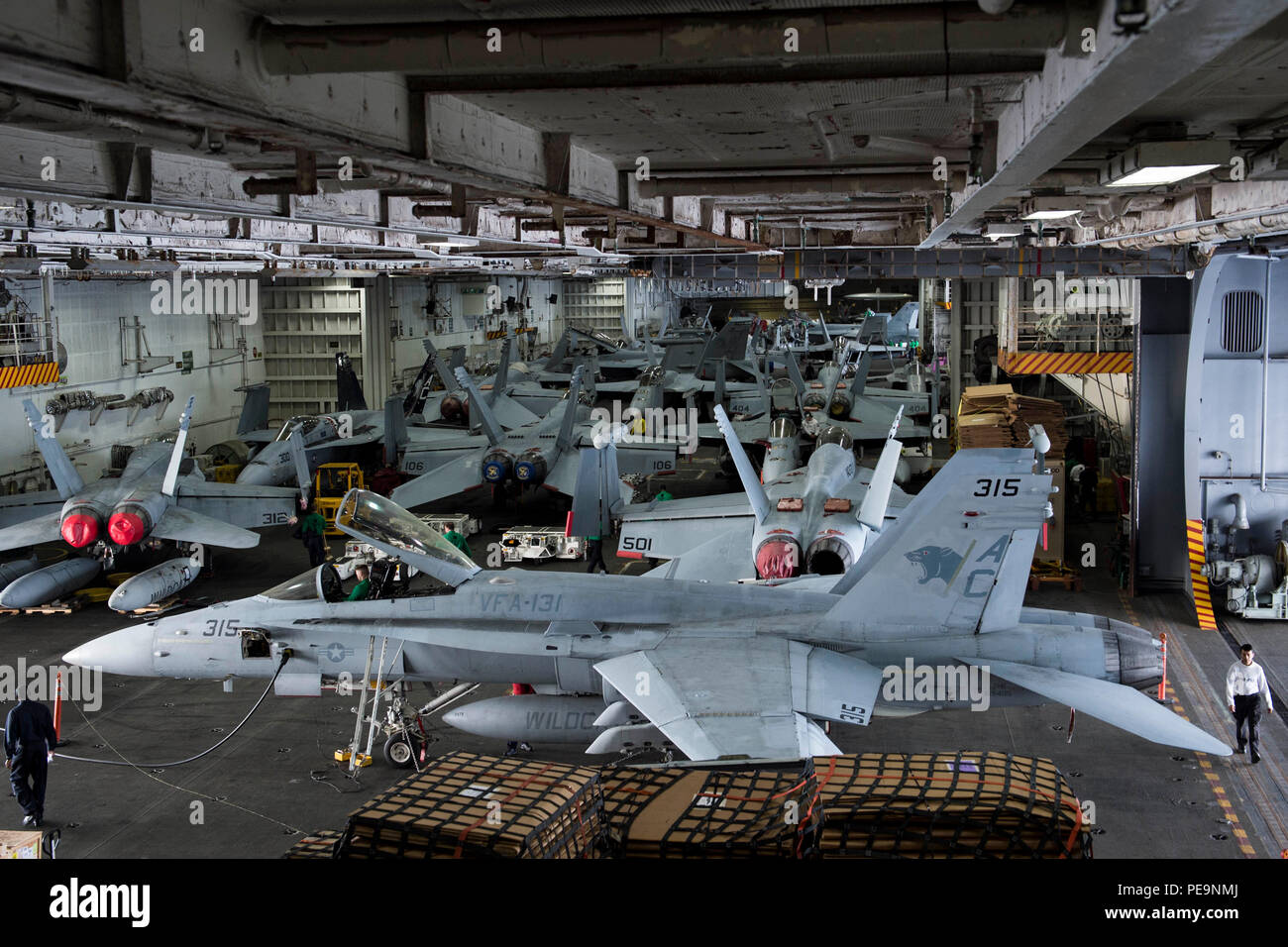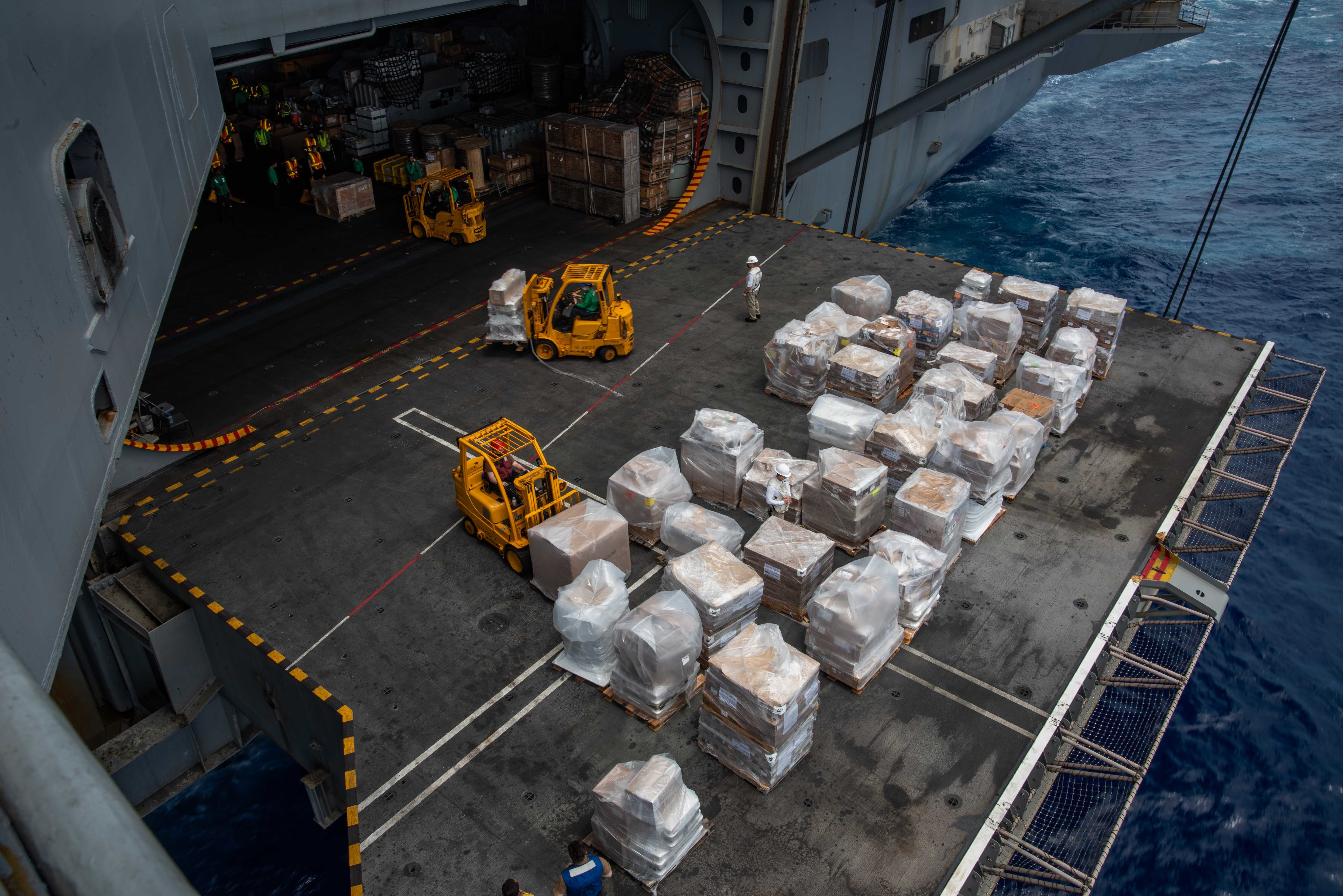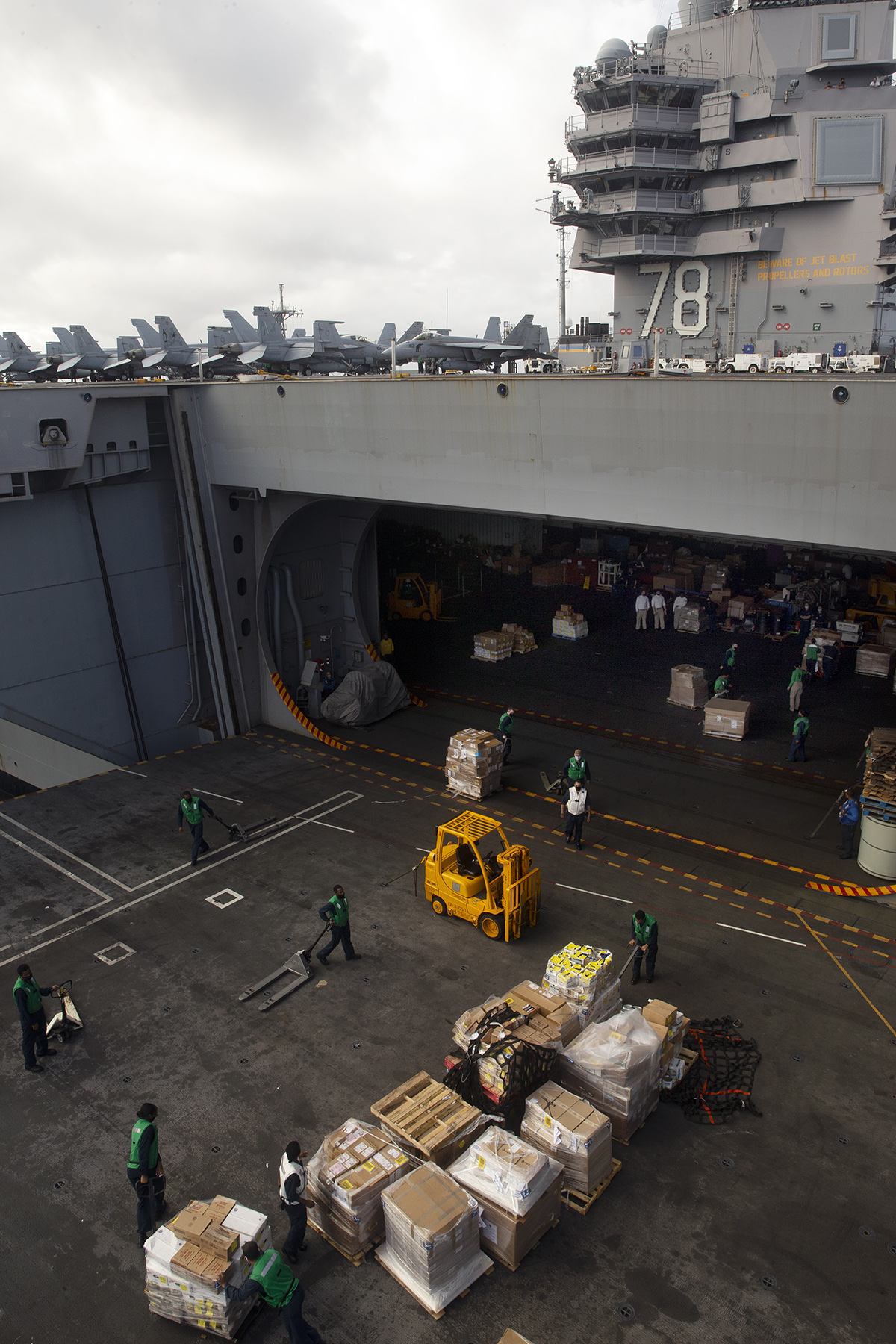Aircraft Carrier Hangar Bay - The flight-deck crew can keep a small number of aircraft up top, but there's not nearly enough room for the 80 to 100 aircraft stationed on a typical carrier. When they're not in use, most of the aircraft are secured in the hangar bay, the "carrier's garage."
Decommissioning and disposal costs to inactivate a Nimitz-class nuclear carrier is estimated at $750 million to $900 million, almost one-quarter the cost of procuring a new Nimitz-class carrier. These costs are normally funded in the Navy's operations and maintenance appropriation account. The nuclear carrier inactivation cost is approximately 20 times the cost estimated for the decommissioning and disposal of conventional carriers currently in the fleet.
Aircraft Carrier Hangar Bay

A carrier with its complement of 50 strike aircraft can deliver more than 150 strikes a day against littoral targets, the prime responsibility of the US Navy. However, should the need arise, relatively long range targets can be attacked. A carrier normally stocks over 4,000 bombs. The Navy plans to upgrade the current tactical airwing from F/A-18Cs and F-14s to a combination of F/A-18C/E/Fs to an all F/A-18E/F airwing and, ultimately, an airwing composed of both F/A-18E/F and a Navy version of the Joint Strike Fighter (JSF).
Chief Petty Officers’ Mess Lounge
Personnel in the three chief petty officer rates (E-7 through E-9) also had conspicuous privileges such as separate dining and living areas. Their mess was off-limits to anyone who not a chief, including the captain himself, except by specific invitation.
Aircraft carriers like USS Hornet were built to be floating airports so pilots were an essential part of the ship. To become a carrier pilot, men and women must pass strict requirements and go through intense training programs. Between January 1941 and August 1945, nearly 325,000 young men entered the cadet training program to fly in World War II. About 191,000 of them, or 59%, graduated. Most of the remaining dropped out while a few perished in accidents during training.
The rank Chief Petty Officer (CPO) is the seventh enlisted rate (with the paygrade E-7) in the U.S. Navy, just above petty officer first class and below senior chief petty officer. Advancement into the chief petty officer grades is the most significant promotion within the enlisted naval grades. At the grade of chief petty officer, the Sailor takes on more administrative duties. In the U.S. Navy, their uniform alters to reflect this change of duty, becoming identical to that of an officer’s uniform except with different insignia.
Mail is very important to sailors deployed at sea. Mail from home delivers emotions, connections, love, and a touch of family. Reading and writing letters are an easy escape from the harrowing experience of war. It brings sailors a reminder of people and places that they love and provides moments of normalcy and reassurance.
Whats Onboard?
The role of the chaplain on board was talking to sailors and offering counseling. A formal Catholic confessional was available aboard USS Hornet (marked out now by curtains) but sailors of any or no faith and regardless of rank could make use of the chaplain’s counseling services by visiting them in their offices. This compartment also contained the ship’s library which functioned similarly to a public library. Bookshelves were lined with new and used books that sailors could read in the space or take with them back to their rooms. Additional bookshelves would have held a collection of the Navy’s professional reading list.
A major part of every aircraft carrier, logically, is the aircraft onboard. Carriers transport dozens of different aircraft specially designed to withstand the constant abuse of catapult takeoffs and arresting-wire landings. A carrier air wing typically consists of nine squadrons, with 70 to 80 total aircraft. The more notable onboard aircraft include:
Lastly, you can see a large vent by the table which is an air conditioning unit. This was installed after WWII. During the 1940s, the only areas that were air conditioned were Sickbay and spaces with sensitive machinery.
Though the plan was to potentially reactivate Hornet at some point in time, detailed inspections in 1981 and 1987 found that her systems were obsolete and the living conditions were outdated for contemporary standards. In 1989, her name was officially stricken from the Naval Registry.
Ge-Dunk
Aircraft carriers are routinely forward deployed around the world, engaging in joint (U.S. Navy, Marines, Army and Air Force) and combined (with other allied nations) exercises. These exercises hone combat skills as well as providing valuable experience in operating with other forces. While deployed, aircraft carriers operate in international waters providing a presence which can be increased or withdrawn as the situation dictates. Should the situation require it, the aircraft carrier and air wing team are ready on arrival to accomplish whatever mission is given, from unobtrusive surveillance to strikes and anything in between. Although aircraft carriers are routinely deployed near traditional areas of potential conflict, the aircraft carrier can move to another area of the world should a crisis erupt, and be ready to operate upon arrival.
The 3rd Deck was almost entirely devoted to living spaces and spaces for Personal Services of the enlisted crew. Examples of Personal Services are the Barber Shop, one of the Ship’s Stores for the enlisted crew, and a snack bar called Ge-Dunk. While sailors ate for free at the enlisted mess, they had to pay for their food at the Ge-Dunk but it was open all day and offered different options such as hot sandwiches, hot dogs, ice cream, candy bars, and other types of easy food. It was considered to be an easy, place to stop by and grab a bite to eat and was popular among the crew. There are a few legends for the origin of the name “Ge-Dunk,” but one favorite is that it was introduced in ships originally as an early vending machine and the coins used made a ge-dunk sound.

There are eight Babock & Wilcox separately-fired superheated boilers situated in four Fire Rooms, two per Engine Room. They produce saturated and superheated steam — saturated (auxiliary) steam for auxiliary machinery, heating, etc., and superheated (main) steam that traveled into the Engine Rooms at 600 psi and 850 degrees Fahrenheit for use in the main engines and main generators. It was HOT working down there, about 30 degrees hotter than the temperature outside!
The draft Naval Vessel Force Structure Requirements report, which was requested by Congress in 1999 and completed in early 2000, called for a fleet of over 360 ships, 44 more than in the current fleet. It would include 15 aircraft carriers, three more than now in service, and 68 attack submarines, a dozen more than in today's force. The Navy would have to spend up to $19 billion for 10 to 12 ships annually, roughly triple the FY2000 budget of $6.4 billion shipbuilding, which funded the construction of six new ships. The Clinton administration's FY2001 shipbuilding budget request for FY2001 was $10.7 billion for eight ships, in including more than $4 billion for the 10th and final Nimitz class aircraft carrier.
Fire Room
Whenever a U.S. Navy aircraft carrier is called out to sea it is part of a battle group. A carrier battle group is a battle group specifically centered around an aircraft carrier with escorts surrounding her. These other ships can include destroyers, smaller escort carriers, and more.
Experienced GTA Online players may wonder why their plane was not shot down while flying close to the ship. According to the footage, five of the cargo have already been transported. This means this is not their first visit to the aircraft carrier, and they may have disabled the defense system during previous visits.
In March 1970, USS Hornet began deactivation at the Long Beach Naval Shipyard in California. One month later she made her way north to Bremerton, Washington to continue deactivation and preservation work. In Bremerton, her boilers and piping systems were drained, machinery and equipment coated in preservation compounds, and her hull was corrosion-proofed. On June 26, 1970 Hornet was formally decommissioned.
USS Hornet has three aircraft elevators. The first is forward centerline and connects Hangar Bay 1 to the Flight Deck near the catapults. The elevator is usually kept in the up position, flush with the Flight Deck. The other two were built on the port and starboard sides off the ship, with one in Hangar Bay 2 and the other in Hangar Bay 3. These elevators were used to quickly move aircraft between the Hangar Deck and Flight Deck, and each could move twenty tons, the weight of a fully fueled and loaded aircraft, between decks in under ten seconds.

Aircraft Elevators
Hornet’s elevators are suspended on twelve cables controlled by a hydraulic piston. The control valve can be operated electrically or manually. When operated electrically, the platform stops only at the Flight Deck or Hangar Deck. When operated manually with a hand wheel, the platform can be stopped at any position.
An airwing consisting of more than 80 combat aircraft and 2,000 Sailors is assigned to each carrier. Squadrons assigned to airwings -- and airwings assigned to carriers -- change periodically based on the mission of the carrier battle group. Carrier-based squadrons fly six different types of aircraft: F/A-18 Hornets, F-14 Tomcats, SH-60 Seahawks, S-3B Vikings, E-2C Hawkeyes and EA-6B Prowlers. Missions range from reconnaissance and search and rescue to logistics and interdiction.
Molotok is an armored and weaponized military fighter jet in GTA Online. Gamers can purchase the plane from the Warstock Cache & Carry website for a starting price of $4,788,000. A trade price of $3,600,000 is also unlocked after completing 18 Air Freight Cargo Missions.
The Navy maintains at least three carriers deployed overseas most of the time, though three carriers constitute only one-quarter of the carrier fleet. In peacetime, some carriers are in repair; others are in US ports to provide stateside duty time for their crews; still others are in transit to their operating stations. But the Navy maintained five of its 13 carriers overseas in the late 1970s, and throughout the 1980s the Navy planned on a third of the 15-carrier fleet being deployed overseas.
Aircraft Catapults
When it was time to drop anchor, sailors would remove the safety pin in each pelican hook with a sledgehammer, use a very large lever to lift the chain, and then slide the pelican hook and its chain out of the way so the anchor chain could run freely as it was released. The sailors would run to the back of the foc’s’le before the chain released so as to be out of the way as it whipped across the deck in a free fall. A brake on the wildcats allowed sailors to stop the chains at the desired depth.
The Captain’s Bridge and Pilot House are where the captain was expected to be when the ship was at sea. From his bridge, the Captain could see 25 miles (40.23 km) in all directions and would give orders to steer the ship back into the Pilot House where the Helmsman would control the ship’s wheel while the Lee Helmsman controlled the ship’s speed.

Sending and delivering mail is made possible by exchanging mail at port of call, or at sea through “underway replenishment (UNREP).” UNREP is the process when two ships moving parallel to each other exchange information, mail, or supplies from one to another while at sea.
Landing challenges are a popular fan-made sport in GTA Online, and many players have performed some incredible landings and stunts in the game. The game's open-world implementation allows intrepid players to accomplish feats that normal gamers cannot.
Brig
The hangar bay is located two decks below the flight deck, just below the galley deck. The bay itself is 110 feet (~34 m) wide, 25 feet (~8 m) high and 685 feet (~209 m) long -- more than two-thirds the length of the entire ship. It can hold more than 60 aircraft, as well as spare jet engines, fuel tanks and other heavy equipment, in four zones divided by sliding doors (a safety precaution to stop a fire from spreading).
An aircraft carrier’s Flight Deck is a dangerous place to work and usually had 300 men working among moving aircraft and machinery—and with none of the fencing you see around the deck today. The ship’s two catapults made it possible to launch aircraft with a limited runway. They are H-8 hydraulic catapults powered with compressed air and could take the aircraft from 0 to 120 mph in about 3 seconds. The machinery to power the catapults is over six decks below with more than 1000 ft of cable connecting the machinery to the Flight Deck track. (This area is sometimes available for docent-led tours.)
In Torpedo berthing, the bulkhead (wall) opposite the torpedo workshop also contains one of the locations from where the ship can be steered if she were damaged in battle. It was made to be used only if the Island and Sec Conn in the Foc’s’le were not operational, which would mean that the ship would be in dire straits. The steering console includes a Rudder Angle Indicator, a compass, a toggle switch to direct the rudder, and sound-powered headphones to listen to directions on how to steer the ship out of danger.
The hangar is three decks high, and it's flanked by various single-deck compartments on both sides. There are also four giant elevators surrounding the hangar, which move the aircraft from the hangar to the flight deck. The high-speed, aluminum hydraulic elevators are big enough and powerful enough to lift two 74,000-pound (~34,000-kg) fighter jets.
Hornet Legacy Room
The ship’s Brig, or its jail, was managed by the Marine Detachment, who acted somewhat as the ship’s police force. It’s small with only 13 beds available, but it was meant to send a message quick. Only the Captain could assign Brig time and the reasons for it were a) if a sailor put the crew in danger or b) if a sailor put the ship in danger. Worse offenders would have been flown off to be tried and jailed on shore but sailors could be assigned to the Brig just overnight to up to two weeks. The Captain could also assign them to just bread and water for the first three days of their stay.
Food for the Wardroom was prepared one deck below in the Wardroom Galley and then brought up to this Wardroom Pantry via dumbwaiter, where it was then plated and served. Some items, like eggs made to order, were cooked here for quick service. The hatch across from the Pantry leads down to both the Wardroom Galley and the Flight Suit Mess, a space where officers could eat without having to put on their full uniform and which was named for the pilots who might be suited up for a mission. The Flight Suit Mess, Wardroom Galley, and Wardroom Pantry were operational 24-hours-a-day to accommodate erratic mission schedules, though officers would have access to more limited menu options off-hours from breakfast, lunch, and dinner.
The name Hornet dates back to the earliest days of the United States and has been carried through eight ships, the last being this aircraft carrier. The first USS Hornet was one of the first two ships commandeered by the Continental Navy to fight against the British during the Revolutionary War. The other was USS Wasp and, together, they were used to “sting the British fleet.”
In WWII, German submarines in the Atlantic caused heavy losses of merchant fleets transporting war materials to Europe and Africa. The U.S. Navy developed new combat techniques with aircraft such as Grumman Avenger torpedo bombers and Wildcat fighter aircraft. Their aircraft carriers and the ships that protected them became known as Hunter Killer Groups (HUK) and helped stem heavy shipping losses.
Marine Detachment
aircraft carrier plane storage, hangar bay aircraft interiors, aircraft carrier hangar deck, airplane hangars for sale, aircraft carrier elevator design, aircraft carrier elevator, airplane hanger kits for sale, airplane hangar cost to build

